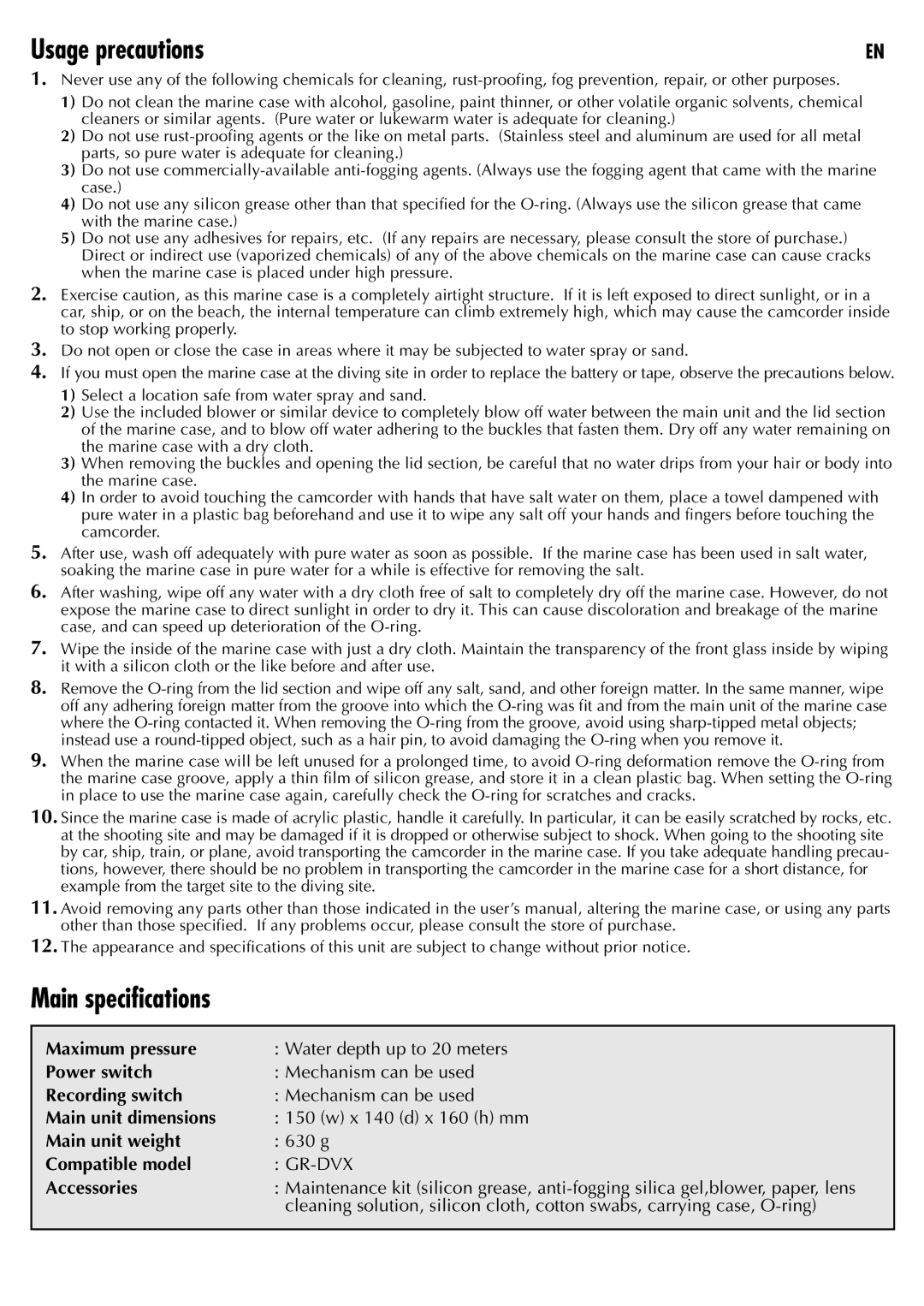Usage precautions | EN |
1.Never use any of the following chemicals for cleaning,
1)Do not clean the marine case with alcohol, gasoline, paint thinner, or other volatile organic solvents, chemical cleaners or similar agents. (Pure water or lukewarm water is adequate for cleaning.)
2)Do not use
3)Do not use
4)Do not use any silicon grease other than that specified for the
5)Do not use any adhesives for repairs, etc. (If any repairs are necessary, please consult the store of purchase.) Direct or indirect use (vaporized chemicals) of any of the above chemicals on the marine case can cause cracks when the marine case is placed under high pressure.
2.Exercise caution, as this marine case is a completely airtight structure. If it is left exposed to direct sunlight, or in a car, ship, or on the beach, the internal temperature can climb extremely high, which may cause the camcorder inside to stop working properly.
3.Do not open or close the case in areas where it may be subjected to water spray or sand.
4.If you must open the marine case at the diving site in order to replace the battery or tape, observe the precautions below.
1)Select a location safe from water spray and sand.
2)Use the included blower or similar device to completely blow off water between the main unit and the lid section of the marine case, and to blow off water adhering to the buckles that fasten them. Dry off any water remaining on the marine case with a dry cloth.
3)When removing the buckles and opening the lid section, be careful that no water drips from your hair or body into the marine case.
4)In order to avoid touching the camcorder with hands that have salt water on them, place a towel dampened with pure water in a plastic bag beforehand and use it to wipe any salt off your hands and fingers before touching the camcorder.
5.After use, wash off adequately with pure water as soon as possible. If the marine case has been used in salt water, soaking the marine case in pure water for a while is effective for removing the salt.
6.After washing, wipe off any water with a dry cloth free of salt to completely dry off the marine case. However, do not expose the marine case to direct sunlight in order to dry it. This can cause discoloration and breakage of the marine case, and can speed up deterioration of the
7.Wipe the inside of the marine case with just a dry cloth. Maintain the transparency of the front glass inside by wiping it with a silicon cloth or the like before and after use.
8.Remove the
9.When the marine case will be left unused for a prolonged time, to avoid
10.Since the marine case is made of acrylic plastic, handle it carefully. In particular, it can be easily scratched by rocks, etc. at the shooting site and may be damaged if it is dropped or otherwise subject to shock. When going to the shooting site by car, ship, train, or plane, avoid transporting the camcorder in the marine case. If you take adequate handling precau- tions, however, there should be no problem in transporting the camcorder in the marine case for a short distance, for example from the target site to the diving site.
11.Avoid removing any parts other than those indicated in the user’s manual, altering the marine case, or using any parts other than those specified. If any problems occur, please consult the store of purchase.
12.The appearance and specifications of this unit are subject to change without prior notice.
Main specifications
Maximum pressure | : Water depth up to 20 meters |
Power switch | : Mechanism can be used |
Recording switch | : Mechanism can be used |
Main unit dimensions | : 150 (w) x 140 (d) x 160 (h) mm |
Main unit weight | : 630 g |
Compatible model | : |
Accessories | : Maintenance kit (silicon grease, |
| cleaning solution, silicon cloth, cotton swabs, carrying case, |
|
|
